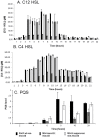The mucoid switch in Pseudomonas aeruginosa represses quorum sensing systems and leads to complex changes to stationary phase virulence factor regulation
- PMID: 24852379
- PMCID: PMC4031085
- DOI: 10.1371/journal.pone.0096166
The mucoid switch in Pseudomonas aeruginosa represses quorum sensing systems and leads to complex changes to stationary phase virulence factor regulation
Abstract
The opportunistic pathogen Pseudomonas aeruginosa chronically infects the airways of Cystic Fibrosis (CF) patients during which it adapts and undergoes clonal expansion within the lung. It commonly acquires inactivating mutations of the anti-sigma factor MucA leading to a mucoid phenotype, caused by excessive production of the extracellular polysaccharide alginate that is associated with a decline in lung function. Alginate production is believed to be the key benefit of mucA mutations to the bacterium in the CF lung. A phenotypic and gene expression characterisation of the stationary phase physiology of mucA22 mutants demonstrated complex and subtle changes in virulence factor production, including cyanide and pyocyanin, that results in their down-regulation upon entry into stationary phase but, (and in contrast to wildtype strains) continued production in prolonged stationary phase. These findings may have consequences for chronic infection if mucoid P. aeruginosa were to continue to make virulence factors under non-growing conditions during infection. These changes resulted in part from a severe down-regulation of both AHL-and AQ (PQS)-dependent quorum sensing systems. In trans expression of the cAMP-dependent transcription factor Vfr restored both quorum sensing defects and virulence factor production in early stationary phase. Our findings have implications for understanding the evolution of P. aeruginosa during CF lung infection and it demonstrates that mucA22 mutation provides a second mechanism, in addition to the commonly occurring lasR mutations, of down-regulating quorum sensing during chronic infection this may provide a selection pressure for the mucoid switch in the CF lung.
Conflict of interest statement
Figures






References
-
- Schaedel C, de Monestrol I, Hjelte L, Johannesson M, Kornfalt R, et al. (2002) Predictors of deterioration of lung function in cystic fibrosis. Pediatr Pulmonol 33: 483–491. - PubMed
-
- Castric PA (1983) Hydrogen cyanide production by Pseudomonas aeruginosa at reduced oxygen levels. Can J Microbiol 29: 1344–1349. - PubMed
Publication types
MeSH terms
Substances
Grants and funding
LinkOut - more resources
Full Text Sources
Other Literature Sources
Medical

